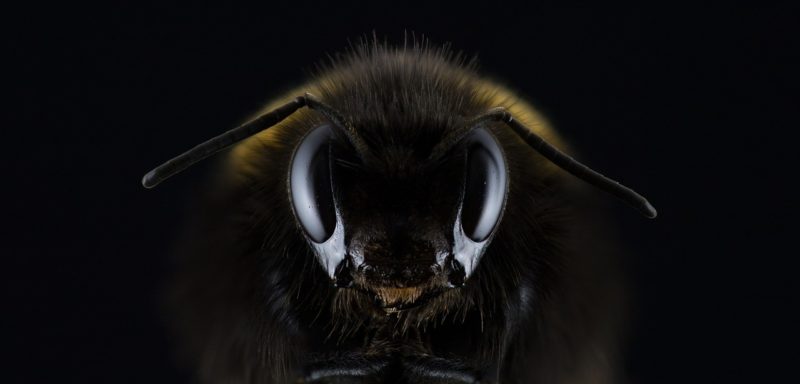by Gill McEvoy
It is quite common to see bumble bees out foraging quite late in the evening, even in cooler weather, long after the honey bee has retired to the hive. The bumble, or humble, bee’s great advantage over the honey bee is its thick coating of hairs on the body, yet while this protects it to a great extent from the cold, it also creates the problem of overheating in hot weather. To counteract the effects of overheating the bumble bee has a remarkable system for cooling its body down: it has an area of smooth skin on the underside of its abdomen known as the ventilation window; in hot weather the bee can seek out a resting place and by directing the flow of blood rapidly through its veins over this window it thereby cools down quite efficiently.
Often we see a bumble bee resting on the ground and we may think it’s dying but it may be there for one of three reasons: to cool itself down; to absorb energy from the heat retained by stones or tarmac; or thirdly it may quite simply be drunk on nectar. With regard to this latter point years ago I met an Irish woman who had a lime tree in her front lawn. All bees love to feed in the nectar-rich flowers of the lime tree: you can hear the lime really humming on a fine summer’s day. When she came home from work one evening she found her lawn covered in ‘sozzled’ bees! This can also happen to wasps from gorging on rotting fallen fruit in the autumn.
Conversely, if a bee needs to warm up and there is no reflected heat from the ground it can actually disconnect its wings and warm itself up by rapid shivering in order to create enough energy to fly. So if you see a bee resting on the ground the best policy is to leave it well alone.
The queen bee warms her eggs in this manner too.
Many bumble bees economise on energy by crawling over the florets of blossom: particularly easy to reach nectar sources like buddleia and flowers of the compositae family – the daisies of all kinds and the dandelions which gardeners so disparage. However bees with long tongues (and some butterflies, including the brimstone) have to hover constantly to probe the deep throats of flowers such as the pea family and the labiates. This requires much more energy of course so some have learned to speed up the process by drilling a hole into the flower tube thus getting at the nectar more quickly. This benefits the bee and saves energy but of course it is of no benefit to farmers or gardeners who depend on bees for pollinating their crops.
In fact bees are so important for this task that we should all take care to plant flowers that feed these vital pollinators and also encourage a few valuable weeds, the dandelion being an excellent one to foster! Our thinking needs to change and sadly, with so many people now paving over front gardens and then cheering it up with a pot of petunias by the front door, we are not doing nearly enough to support bees. Whether you fill your garden with flowers or look into crowdfunding to raise funds for organizations who support bees, we should all be doing our bit to save our little yellow and black friends.
Sometimes bees will delight you with their private behaviour; I once observed a small bumble bee crawling into the tube of an iris bloom, followed shortly afterwards by a larger bee choosing the same tube; a bulge appeared in the tube and then the second bee backed out very quickly. I have no idea whether there was an argument inside or not but it was quite something to see!
And once I had the extreme pleasure of watching a leaf-cutter bee fly in at my feet one day when I was sitting in the garden having tea. It had just visited a rose bush and snipped out a chunk of leaf bigger than itself; it flew in, the piece of leaf clutched in its feet rather like someone cruising in spread-eagled on a flying carpet. It rested on the ground for a while, then began to roll the leaf up, working with its legs and proboscis to fashion the tube. When it had finished it seized the rolled leaf in its feet and flew off. Although I knew that the leaf cutter makes many such tubes, lays an egg in each and stops it up with pollen mix to feed the larva when it hatches I had never before seen any part of the process, and to have observed this much was a real joy and privilege. Such a small creature and such an exquisite, elaborate act of creation!
I cannot pretend to know a huge amount about bees and can only share the little I do know plus the anecdotes I’ve mentioned, but I find bees are endlessly fascinating to watch. One last thing I would like to share is that when I was a child my family had friends who kept bees. The couple in question lived in the middle of a five-hundred-acre wood in a large clearing with a big pond in it. This, however, may not be possible for most people. I’ve heard that some people make use of their greenhouses to grow these little ones. But, Can You Keep Bees in a Greenhouse? I guess it depends on how well you set up the beehive in the greenhouse. Like I said, I’m not an expert at beekeeping, but I am extremely fascinated by it nonetheless. Once it happened that a particular plant burgeoned around the pond and the bees trawled it avidly; I cannot remember now whether it was loosestrife or meadowsweet – probably not meadowsweet as mostly flies visit its flowers, not bees – but when I was taken to see inside the hive one evening at dusk I was astonished to see a phosphorescent glow beam out from its interior, an intense greenish glow that made me think of the comics my brother and I read – which were not from the 2 major competing universes (as you can see if you click here, the battle still very much rages on between them), but rather The Eagle with its Mekon and Dan Dare – and truly I thought the aliens had arrived. I stood there open-mouthed, my first experience of the utterly mesmerising magic of wild things. An unforgettable experience that has tinged all my subsequent witnessed revelations from nature with glamour and delight.
Gill McEvoy: 2 collections of poetry from Cinnamon Press, 3 pamphlets from Happenstance Press of which The First Telling won the Michael Marks Award in 2015. Gill is a very keen observer of wildlife.

